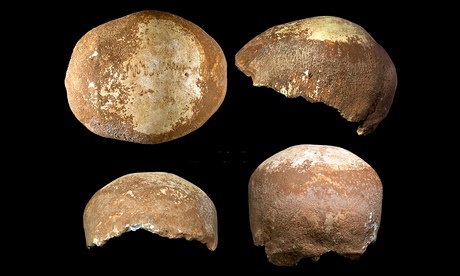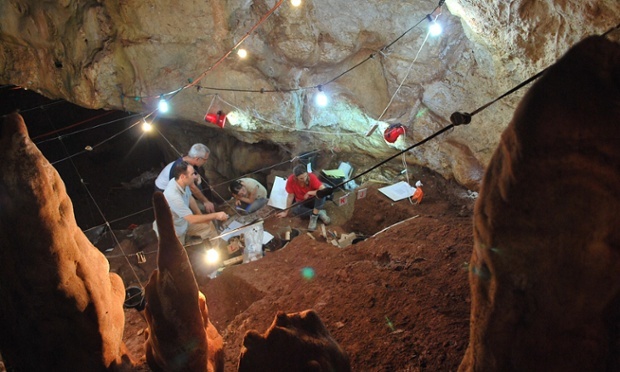
An ancient skull found in a cave in northern Israel has cast light on the migration of modern humans out of Africa and the dawn of humanity's colonisation of the world.
For most palaeontologists that might be enough for a single fossil, but the braincase has offered much more: a likely location where the first prehistoric trysts resulted in modern humans having sex with their heavy-browed Neanderthal cousins.
Discovered in a cave in western Galilee, the partial skull belonged to an individual, probably a woman, who lived and died in the region about 55,000 years ago, placing modern humans there and then for the first time ever.
Homo sapiens walked out of Africa at least 60,000 years ago, but the harsh climate in parts of Europe at the time hampered their spread across much of the continent until about 45,000 years ago.
The skull reveals that modern humans reached the Levant where the population may have given rise to those who later colonised Europe when the frozen climate abated and the territory became more habitable.
Israel Hershkovitz at Tel Aviv University said the skull, though missing its face and jaws, was an extraordinary find. Distinctly modern in its anatomy, the braincase resembles the European Cro-Magnons (robustly built early modern humans), but retains some African features too. "It's amazing. This is the first specimen we have that connects Africa to Europe," Hershkovitz told the Guardian.

When scientists abseiled through the hole torn in the ceiling, they found the cave opened up more than 20 metres deep, 50 metres wide and 100 metres long. The original entrance to the cave had collapsed about 30,000 years ago, sealing off the contents.
"We couldn't believe our eyes. We immediately realised it was a prehistoric cave and that it had been inhabited for a very long time. Because the entrance had collapsed so long ago, it had been frozen in time. Nobody had been inside for 30,000 years," said Hershkovitz.
"There is a huge central cave and several beautiful side chambers. In one side chamber, the skull was lying there on top of a rocky shelf. It was there waiting for us. We just had to pick it up," he added.
Excavations at the site have yielded an impressive haul of modern human and antelope bones, but the partial skull is the oldest of the human remains recovered from the cave. How it came to be perched on a shelf in a side chamber of the cave is a mystery: it may have come to rest there after being washed in by floodwater. Or perhaps it was placed there intentionally by another individual living in the cave.
Writing in the journal Nature, the scientists explain how dating the skull to 55,000 years ago reveals that modern humans arrived in the region when it was already well populated with Neanderthals. Skeletons of Neanderthals from the same time have been recovered from Amud cave 24 miles (40km) to the east of Manot cave, and from Kebara cave 30 miles to the south.
That modern humans and Neanderthals shared the land around Manot cave 50,000 to 60,000 years ago means that the rolling hills of what is now Galilee may have provided the romantic backdrop to the spell of interbreeding that left non-Africans with a smidgen of Neanderthal DNA. Genetic studies suggest that humans and Neanderthals mixed in the same 50,000 to 60,000-year-old period, most probably in western Asia.
"Manot is the best candidate for the interbreeding of modern humans with Neanderthals and there is really no other candidate," Hershkovitz said. "The people at Manot cave are the only population we know of that shared the same geographical region for a very long period of time," he added. Without DNA from the skull, it is impossible to know if the Manot cave individual was a product of such couplings.
Chris Stringer, head of human origins at the Natural History Museum, said the region was certainly a contender for the main interbreeding that happened 50 millennia ago, though further north than modern day Israel was possible.
"At about 55,000 years old, this is the first modern human from western Asia which is well dated to the estimated timeframe of interbreeding between early modern humans and Neanderthals," he said.
"Manot might represent some of the elusive first migrants in the hypothesised out-of-Africa event about 60,000 years ago, a population whose descendants ultimately spread right across Asia, and also into Europe. Its discovery raises hopes of more complete specimens from this critical region and time period," he added.



Since our understanding of pre-history is all theory anyway, why not liven things up a bit with a nod to cave sex. 'Quest for Fire' anyone?